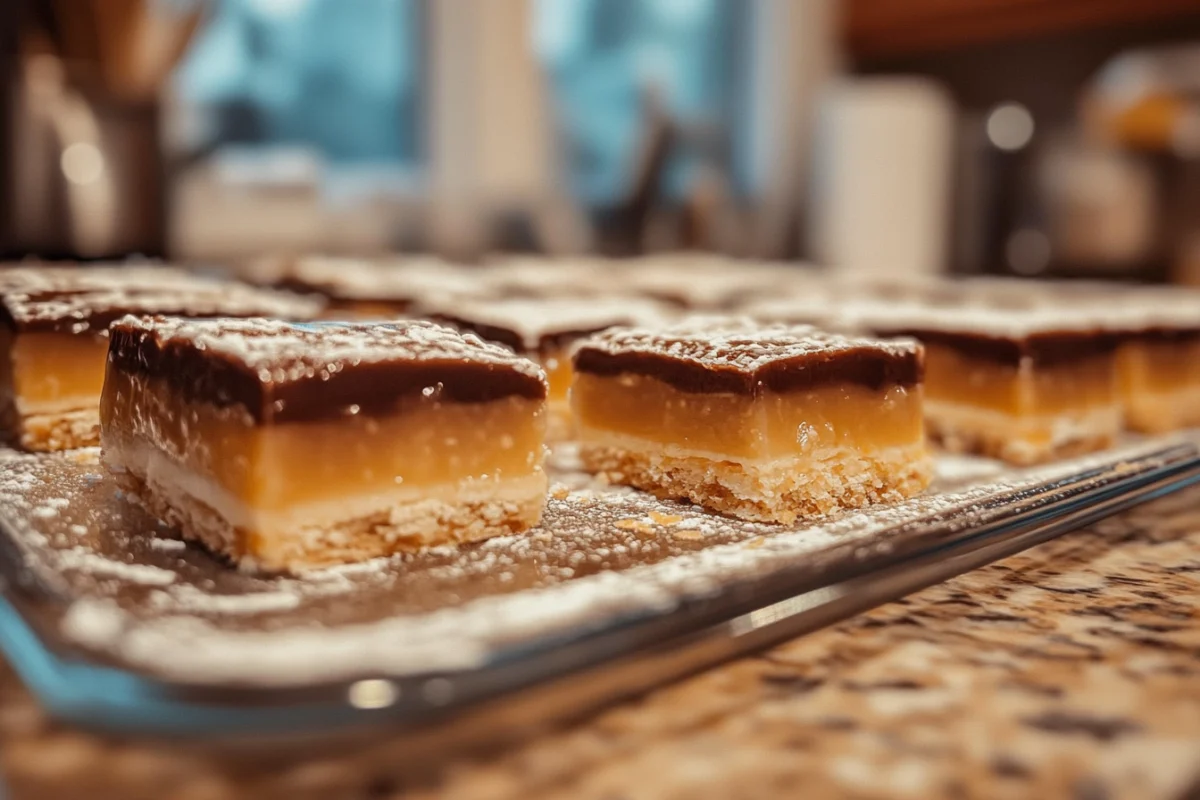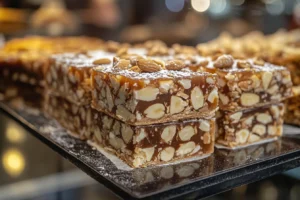How do you eat turrón? Turrón is a traditional Spanish sweet that has been enjoyed for centuries, especially during the holiday season. It is often considered the Spanish equivalent of nougat. The treat is made primarily from almonds, honey, sugar, and egg whites. It has two main types:
- Turrón de Alicante: A hard, crunchy version that is packed with whole almonds.
- Turrón de Jijona: A softer, chewier variety, with a smoother texture.
Turrón is typically enjoyed as a dessert during Christmas time, although its popularity has extended throughout the year in Spain and Latin American countries.
For a deeper dive into the rich history of turrón, consider exploring our detailed guide.
Cultural Significance of Turrón
Turrón has deep historical roots in Spain. It dates back to the 12th century, introduced by the Moors during their occupation of the Iberian Peninsula. The combination of almonds and honey, along with local ingredients like sugar and egg whites, created a delicious treat that is now integral to Spanish Christmas traditions.
- Turrón is especially popular in Alicante, Jijona, and other regions of Spain.
- The treat is usually shared with friends and family during Christmas dinners, symbolizing festivity and togetherness.
In other parts of the world, such as Mexico and Argentina, turrón has become a beloved dessert as well, often made with local variations.
Why Is Turrón Special?
Turrón stands out for its unique texture and flavor. Whether it’s the crunchy almonds in Turrón de Alicante or the smooth, creamy texture of Turrón de Jijona, each bite is an experience that blends sweetness, richness, and a hint of almond flavor. Unlike many other sweets, turrón’s primary ingredients are wholesome and nutritious.
The diversity in flavors and textures is part of what makes turrón so special. Each variety offers a different sensory experience, making it suitable for various preferences, from those who enjoy a harder bite to those who prefer a chewy, melt-in-your-mouth sensation.
Varieties of Turrón and How do you eat turrón?
Turrón de Alicante
Turrón de Alicante is the hardest of the turrón varieties. It is made by mixing almonds, sugar, and honey, creating a crunchy texture. This variety is often sold in large slabs, which can be broken into pieces with a knife or hammer.
- How to eat it:
- Break it into small pieces using a nutcracker or knife.
- Best paired with sherry or a fortified wine such as Port.
- Enjoy alongside a strong coffee for a delightful contrast in textures.
- Serving Tips:
- Turrón de Alicante pairs beautifully with bubbly drinks like Cava (Spanish sparkling wine).
- It is also ideal when served with fresh fruits like apples or pears, balancing the sweetness with a refreshing contrast.
Turrón de Jijona
Turrón de Jijona, on the other hand, is softer and creamier. It is made with finely ground almonds that are mixed with sugar and honey. The result is a smooth, almost paste-like texture.
- How to eat it:
- Slice the turrón into thin pieces using a sharp knife.
- It can be easily spread onto toast or served as a filling for other desserts.
- This softer variety is often enjoyed on its own or as part of a dessert platter.
- Serving Tips:
- Turrón de Jijona goes well with warm drinks like hot chocolate or coffee.
- For a more festive experience, try serving it with sliced strawberries or roasted nuts on the side.
- Turrón de Jijona also pairs wonderfully with a variety of cheeses, especially aged Manchego.
Turrón de Chocolate
Another popular variant is Turrón de Chocolate, which combines the classic ingredients of turrón with the indulgent flavor of chocolate.
- How to eat it:
- Slice or break the turrón into bite-sized pieces.
- Perfect for chocolate lovers, it is often paired with a rich red wine or espresso.
- You can also serve it as a topping for ice cream or pudding for an added layer of flavor.
- Serving Tips:
- Turrón de Chocolate can be served chilled or at room temperature, depending on your preference.
- Pair it with a creamy dessert wine like Muscat or a coffee liqueur to bring out the chocolate’s depth.
Other Regional Varieties
In addition to the well-known varieties like Turrón de Alicante and Turrón de Jijona, there are several other regional variations found throughout Spain.
- In Catalonia, you might encounter Turrón de Yema – a variety made with egg yolks and sugar.
- In the Basque Country, you may find Turrón de Tarta de Santiago, which includes almond flour, and is often served in pie form.
- How to eat them:
- These regional turrón varieties can be served in the same manner as the traditional types, though their specific flavor profiles may pair better with certain wines, cheeses, or fruits.
- Serving Tips:
- Regional varieties can be enjoyed in the same way as other turrón types but experiment with different flavors and pairings based on your preferences.
Best Ways to Serve and Pair Turrón
Turrón as a Dessert
Turrón is a versatile dessert that can be enjoyed on its own or as part of a larger sweet spread. Due to its richness and distinct texture, it can make a statement on any holiday table or dinner setting.
- How to serve turrón as a dessert:
- Slice into bite-sized pieces for a simple presentation.
- Alternatively, break the turrón into smaller chunks using a nutcracker for a more rustic approach.
- Serve it on a platter with other Spanish sweets such as polvorones or marzipan.
- Garnish with a sprinkle of chopped almonds or a dusting of powdered sugar for an elegant finish.
- Tips for enjoying turrón as a standalone treat:
- Turrón de Jijona (soft variety) can be spread on a crusty bread or toast for a lighter option.
- For a fun twist, serve turrón with a small scoop of ice cream (preferably vanilla or caramel) for added sweetness and contrast in texture.
Pairing Turrón with Wine
Wine and turrón make an excellent pairing, enhancing the flavors of both. Different varieties of turrón call for different wines, making it easy to create a perfect match.
- Turrón de Alicante (hard variety):
- Pairs wonderfully with a dry white wine such as Cava or a light, fruity red like Garnacha.
- For an elevated experience, Sherry (especially Fino or Amontillado) brings out the nutty notes of the almonds in the turrón.
- Avoid overly sweet wines, as the sweetness of the turrón itself will overpower them.
- Turrón de Jijona (soft variety):
- This variety pairs best with a full-bodied dessert wine such as Muscat or Pedro Ximénez Sherry.
- If you prefer a more refreshing pairing, champagne or Prosecco works well with the rich, chewy texture of Turrón de Jijona.
- Turrón de Chocolate:
- This chocolate-based treat pairs excellently with a glass of Port wine or a rich red like Syrah or Malbec.
- A coffee liqueur such as Kahlúa is also a great choice for those who enjoy the combination of chocolate and coffee.
Pairing Turrón with Coffee or Hot Drinks
The richness of turrón complements the bitterness of coffee, making it a delightful pairing. Whether you’re enjoying a small piece after a meal or serving it during a coffee break, here’s how you can enjoy turrón with hot beverages:
- Turrón de Alicante pairs wonderfully with a strong espresso or a dark roast coffee.
- For a lighter option, try pairing Turrón de Jijona with a latte or cappuccino for a smooth, creamy experience.
- Hot chocolate is an ideal pairing for Turrón de Chocolate. The sweetness of the chocolate turrón and the richness of hot chocolate create a perfect balance.
Serving Turrón with Fruits and Nuts
Pairing turrón with fruits and nuts adds a refreshing balance to the sweetness of the treat. The freshness of fruits contrasts nicely with the rich, nutty flavor of turrón, while nuts further emphasize the almond flavor.
- Fruits such as apples, pears, or grapes work perfectly with turrón, particularly the hard varieties like Turrón de Alicante.
- For a more indulgent pairing, serve roasted almonds, hazelnuts, or walnuts alongside your turrón. These nuts enhance the almond flavor in the turrón and add texture.
Health Considerations and Myths About Turrón
Nutritional Value of Turrón
While turrón is undeniably a sweet treat, it also contains ingredients that have nutritional benefits, especially the almonds. Here’s a breakdown of its main nutritional components:
- Almonds:
- Almonds are rich in healthy fats, protein, and fiber, making turrón a relatively nutritious option compared to many other sugary treats.
- They are also a great source of vitamin E, magnesium, and antioxidants, which can support heart health and skin health.
- Sugar and Honey:
- While turrón does contain sugar and honey, which contribute to its sweetness, they also provide a quick energy boost.
- Honey, in particular, has antioxidant and anti-inflammatory properties, which can offer some health benefits when consumed in moderation.
- Egg Whites:
- Egg whites provide protein and help to give the turrón its smooth texture, making it a better option than other candies that rely on processed ingredients.
However, as with all sweets, it’s important to enjoy turrón in moderation due to its high sugar content.
Is Turrón Good for You?
While turrón contains healthy ingredients like almonds and honey, it is still a calorie-dense food that should be consumed in moderation, especially if you are watching your sugar intake.
- Benefits:
- Turrón is a great source of energy, making it ideal for holiday feasts or as a quick snack.
- It can be a satisfying dessert for those who want something with a nutty flavor profile, instead of overly sweet confections.
- Drawbacks:
- Due to its sugar content, consuming turrón frequently can lead to weight gain if not balanced with a healthy diet.
- Some varieties of turrón may not be suitable for those with nut allergies.
Is Turrón Gluten-Free?
Yes, most traditional varieties of turrón are gluten-free. The primary ingredients almonds, honey, sugar, and egg whites do not contain gluten, making it a safe choice for those following a gluten-free diet. However, always check the packaging for potential cross-contamination or any added flour in certain commercial brands.
- Tip:
- If you are buying turrón from a store, verify that it is labeled as gluten-free, especially if you are purchasing flavored varieties that may contain additional ingredients.
Common Myths About Turrón
Myth 1: Turrón is Only for Christmas
One of the most common myths about turrón is that it’s only for Christmas. While it’s true that turrón has deep-rooted associations with the holiday season in Spain and other countries, it can be enjoyed year-round.
- Turrón year-round:
- Turrón is made with almonds, honey, and sugar, all of which are widely available throughout the year, making it possible to enjoy at any time.
- Innovative uses: Turrón is becoming increasingly popular as an ingredient in other desserts, such as turrón ice cream, turrón truffles, and turrón-flavored pastries, making it suitable for all seasons.
Myth 2: Turrón is Just a Sugary Treat
Another myth is that turrón is nothing but a sugary treat with no nutritional value. In reality, turrón contains almonds, which are an excellent source of healthy fats, protein, and fiber.
- Almonds and honey:
- The almonds in turrón provide a good amount of vitamins, including Vitamin E, which has antioxidant properties, and magnesium, which supports muscle function.
- Honey, a key ingredient in many turrón varieties, is known for its anti-inflammatory and antioxidant properties, offering health benefits when consumed in moderation.
Myth 3: Turrón is Only Made in Spain
While turrón has its origins in Spain, it is not limited to Spanish borders. In fact, turrón is made and enjoyed in several other countries, particularly in Latin America.
- Turrón outside Spain:
- Mexico, Argentina, and Chile all have their own variations of turrón, often incorporating local ingredients like dried fruits or cocoa.
- These countries often put their own spin on the classic recipe, adding flavors like cinnamon, vanilla, or chocolate, resulting in unique takes on the traditional treat.
Myth 4: Turrón Is Too Complicated to Make
Many people assume that making turrón at home is too complicated or requires special skills. However, making homemade turrón is simpler than most people think.
- Homemade turrón:
- With just a few ingredients like almonds, honey, sugar, and egg whites, you can make turrón in your own kitchen.
- There are numerous easy-to-follow recipes available online that break down the process step-by-step, making it accessible for beginners.
- DIY tips: If you don’t have a mold, you can simply form the turrón into a rectangle or square shape on parchment paper.
FAQs About Turrón
What is the best way to store turrón?
The best way to store turrón is in a cool, dry place, ideally in an airtight container. If you’re not going to consume it right away, you can store it in the refrigerator for longer shelf life, especially if the turrón has a soft texture like Turrón de Jijona.
- Storage tips:
- For Turrón de Alicante (hard variety), keep it in a sealed container to preserve its crunchiness.
- If you store turrón in the fridge, it’s a good idea to let it come to room temperature before eating so it regains its full flavor and texture.
Is turrón gluten-free?
Yes, most traditional turrón varieties are naturally gluten-free, as they are made from almonds, honey, and egg whites. However, it’s always best to check the label for any potential gluten contamination or the use of additional ingredients that may contain gluten, especially in commercial brands.
Can I make turrón at home?
Absolutely! Making turrón at home is easier than you might think. You’ll need basic ingredients like almonds, sugar, honey, and egg whites. Follow a simple recipe, and you’ll be able to create your own delicious turrón without much hassle.
- Tips for homemade turrón:
- Use high-quality almonds for the best taste.
- Ensure you cook the sugar and honey mixture carefully to avoid burning.
How long does turrón last?
When stored properly in a cool, dry place, turrón can last for several weeks. It’s important to keep it in an airtight container to prevent it from becoming stale or losing its flavor.
- Turrón de Alicante (hard) typically lasts longer than Turrón de Jijona (soft), which may need to be consumed sooner.
Can turrón be served with other desserts?
Yes, turrón can be an excellent complement to other desserts. Try serving it alongside ice cream, cakes, or fruit for a more elaborate dessert spread. It can also be incorporated into other recipes, such as turrón ice cream or turrón-flavored cakes.
Conclusion
Embrace Turrón Beyond Christmas
Turrón’s delicious flavor and versatility make it an ideal treat for any occasion, not just Christmas. While it’s a traditional Christmas dessert in Spain and Latin America, there’s no reason why you can’t enjoy it throughout the year.
- Year-round enjoyment:
- Turrón can be a great option for birthday parties, celebrations, or special occasions.
- With its variety of textures and flavors, there’s a turrón to suit every taste, from hard and crunchy to soft and chewy.
Creative Ways to Use Turrón
Turrón can be used in dessert recipes beyond just serving it in slices. Some creative ways to incorporate turrón into your daily routine include:
- Turrón ice cream – Blend pieces of turrón into vanilla or chocolate ice cream for a flavorful twist.
- Turrón truffles – Crush turrón and roll it into bite-sized truffles for a fun, indulgent treat.
- Turrón cake – Use crumbled turrón as a layer in a tart or cake for added texture and flavor.
For a full comparison between turrón and nougat, read more about the difference between turrón and nougat. Embrace the world of turrón and add it to your year-round dessert repertoire today!



